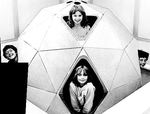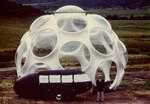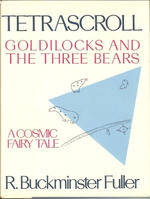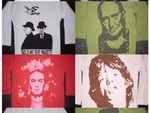I haven't decided if I'm going to bid on it yet, but with a starting bid of $45, I guess there's no use worrying if it'll end up being expensive. This is the first copy of the 1957 catalogue for Creative Playthings' playground subsidiary, Play Sculptures, I've seen on eBay in the almost-a-year I've been watching for such things. [update: it went for 'only' $102.50. damn.]
As Prof. Amy Ogata put it, CP's concept for Play Structures was playground toys by artists and industrial designers which would "redefine the conventional jungle gym through art." They held a design competition [co-sponsored by MoMA and Parents magazine], built full-scale versions of the winners in MoMA's sculpture garden for kid-testing, and put at least four of the designs into production.
The designs in this little catalogue--only 32 pages, so small, why bid, right?--emphasized collaborative play [less or no turn-taking required], abstract design feeding a kid's imagination, and built-in safety [at least by the standards of the mid-50s].
Unfortunately, it seems only a few playgrounds ever got the full Play Sculptures treatment. Two that did, though, kind of send up red flags for me, making me wonder if this whole vintage modernist kidworld fascination thing isn't a huge freakin' mistake.

As Ogata recounds, one of the big gets for Creative Playthings/Play Scultpure's marketing department was building a playground next to the Model Home at the American National Exhibition in Sokolniki Park in Moscow. Russia. The playground was next to the free Pepsi Stand. The Eames' seven-screen, multimedia extravaganza Glimpses of the USA was projecting inside Buckminster Fuller's geodesic dome nearby. Play Sculptures--and Eames, Fuller, the whole lot--were meant to link modern art, creative expression, political democracy, and consumerist abundance--America as presented by GE and Vice President Richard Nixon. Glad that's turned out so well.
In addition to a model home designed for Cold War propaganda, then, Play Sculptures--or at least their concept, realized by one of their former designers--turned up on the archetype of 1960s suburban mega-planning, Reston, Virginia. PS designer David Aaron was tasked in 1964 with designing the play areas throughout the ground-up exurb of Washington, DC. According to an article in Industrial Design, they were designed to "discourage rough-house activities like cops-and-robbers, making these areas safe for very small children." A nice double jab at the 60's scourges of urban blight and juvenile delinquency.
Now, my mother in law lives in Reston. We stop at Chick-Fil-A in Reston after international flights into Dulles. I got nothing special against Reston. But I do know that a prediction made in 1964, that "one carefully thought out, attractive town might save the world," didn't work, even if it turned out as its planners planned.
Whatever our motives for embracing simpler, "better" designs today, I can't ignore the fact that these things were created and propagated and tried before, on previous generations of kids: our parents and us. How do we know we're not only becoming our parents, but turning our kids into our parents, too?
Or is this rambling attempt to say we need to de-romanticize and de-idealize modernist design a bit, and we need to remember better the context that created it, just a roundabout way of saying, "please don't bid against me for that book?"





Grew up with an elementary school that had a bunch of that equipment. Remember the turtle lovingly. Sure beats the designed-by-liability-lawyer made-by-extruded-coke-bottle stuff now.
Nice post. I think one of the slides in that catalog is by Antonio Vitali.
Oh yeah! I same similar happy memories of a playground in Oxnard, CA. I had just moved back to the states from Italy (where my dad was stationed) and the huge turtle was always a draw for me. It beat the heck out of the Navy's idea of a playground (which usually included the all-metal play structure that was responsible for a broken wrist or two.)
We totally had that turtle in San Diego in the 70s/80s. NYC playgrounds are so boring--only slight variations on the same stuff.
We had one of those turtles, too. I remember being very small, and crawling underneath it because you could dig your hands and feet into the sand and it would be nice and cool no matter how hot it was outside.
Growing up in Hawthorne California, I remember the turtle as well as the modernistic play sculpture "village" in Holly Glen Park. None of the pieces remain... but I also fondly remember the turtle. We would push the sand up around the edges and crawl inside our 'turtle-cave'. It was fun for climbing as well.
The best fun with those swiss cheese structures was the one with the semi-solid roof. We'd make a mountain of sand a distance from the structure... then run and do our best to land atop the pile of sand! You just had to be careful not to fall in the hole - ouch! Looking at them now and squelching my nostalgia, I can't help thinking of a bomb shelter aftermath.
If you ever come across this catalog of creative playthings play sculptures I would really like to purchase a copy. My father designed and built two play sculptures for them and it would be nice to have something to show my kids.
Bob Winston MD
Dr. Winston, did your father design the Play Sculptures concrete turtle?